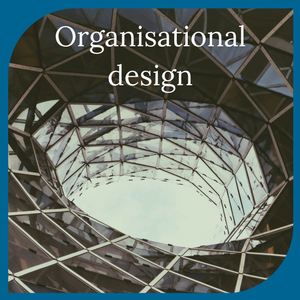
An organisational design for SMEs is an exciting challenge and is usually due to business growth, or is triggered by the need to improve service delivery or specific business processes. When these occur, it is time to review the company organisation.
Organisational design is the process of aligning the structure of an organisation with its objectives with the aim of improving efficiency and effectiveness to continue to be successful.
Traditional and contemporary organisational designs
Organisational designs fall into two categories, traditional and contemporary. Traditional designs include simple structure, functional structure and divisional structure. They have a familiar power dynamic, someone leads and others follow. Contemporary designs would include team structure, matrix structure, project structure, boundary less structure and the learning organisation. The team structure transfers power from middle management to employees.
Organisations are evolving
Organisations tend to evolve therefore the way in which a business operates also needs to evolve. As SMEs grow and the challenges in the external environment become more complex, businesses processes, structures and systems that once worked become barriers to efficiency, customer service, employee morale and financial profitability.
SMEs that don’t periodically renew themselves suffer from such symptoms as:
- Inefficient workflow with breakdowns and non-value-added steps
- Fragmented work with little regard for the good of the whole (and production of bad parts to meet quotas)
- Lack of knowledge and focus on the customer
- Silo mentality and turf battles
- Lack of ownership (“It’s not my job”)
- Cover up and blame rather than identifying and solving problems
- Delays in decision-making
- Employees do not have information or authority to solve problems when and where they occur
- Management, rather than the front line, is responsible for solving problems when things go wrong
- It takes a long time to get something done
- Mistrust between workers and management.
The process
Organisational design is a step-by-step methodology which identifies dysfunction in all aspects of work flow, procedures, structures and systems, it realigns them to fit the current business realities and goals, and then develops plans to implement the new changes. The process focuses on improving both the technical and people side of the business.
It's about more than designing a structure, it also involves:
- Understanding the imperative for change and the environment
- Understanding the business processes, workflows, roles and responsibilities
- Understanding the volumes of work, activity analysis and resources
- Designing and testing new models or structures
- Planning and managing the transition from the old structure to the new
- Implementing and monitoring the change.
Effective organisation design
For most SMEs, the design process leads to a more effective organisation design, significantly improved results (profitability, customer service, internal operations), and employees who are empowered and committed to the business. The trademark of the design process is a comprehensive approach to organisational improvement that touches all aspects of organisational life, so SMEs can achieve:
- Excellent customer service
- Increased profitability
- Reduced operating costs
- Improved efficiency and cycle time
- A culture of committed and engaged employees
- A clear strategy for managing and growing the business.
By design, SMEs want the integration of people with core business processes, technology and systems. A well-designed organisation ensures that the form of the organisation matches its purpose or strategy, meets the challenges posed by business realities and significantly increases the likelihood that the collective efforts of people will be successful.
Organisational design is a continuous process and not just a one-off change intervention.
SME’s that are supported by an HR professional, will have the expertise in place to ensure that there is a need to develop skills, analysing and acting on data and information, and using this to provide insight across the business.
Organisation design work involves groups of people within the organisation to maximum engagement. It gives them ownership and allows contribution for the success of the business and its employees.